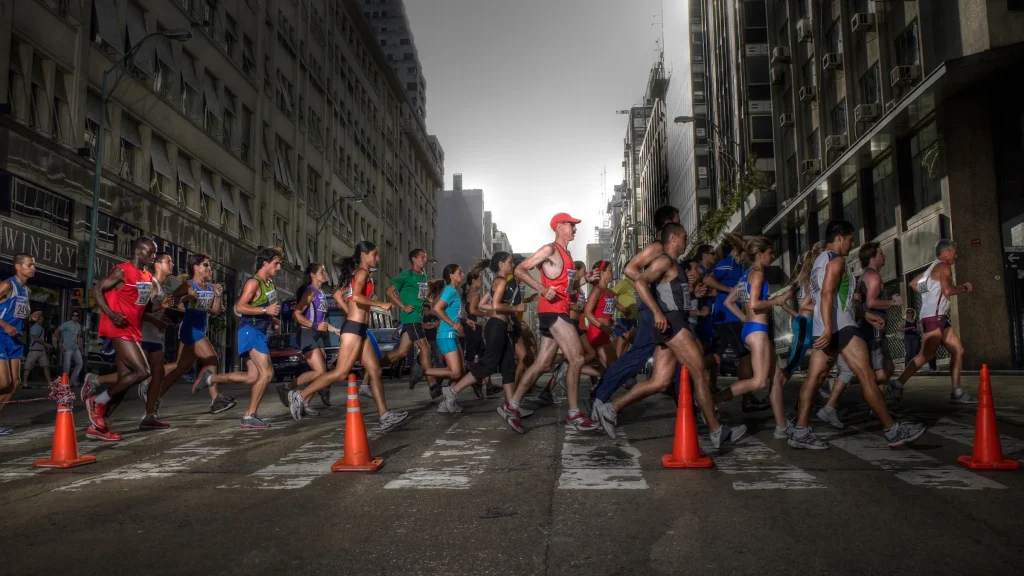
In the early morning parks, running enthusiasts are sweating profusely, unaware of the potential health risks hidden within.
The relationship between exercise and cancer risk is far more complex than we imagine. A study presented at the 2025 American Society of Clinical Oncology (ASCO) annual meeting revealed shocking results: long-distance running, such as ultramarathons, may be associated with an increased risk of colorectal cancer.
This study focused on long-distance runners aged 35 to 50. Among 100 marathon and ultramarathon runners who underwent colonoscopies, nearly half were found to have intestinal polyps, with 15% diagnosed as advanced adenomas—lesions closely linked to colorectal cancer and related mortality risks. This proportion is significantly higher than that in the general population and even exceeds that of certain groups prone to colorectal cancer.
Exercise and Cancer Prevention: Proven Protective Mechanisms
Regular exercise indeed has clear cancer-preventive effects. Research from Tel Aviv University in Israel indicates that high-intensity aerobic exercise can reduce the risk of metastatic cancer by 73%. Exercise works through multiple mechanisms:
Exercise enhances the activity of immune cells, including natural killer (NK) cells, lymphocytes, and macrophages. It promotes blood circulation, allowing immune cells to reach various parts of the body more quickly and improving the body’s ability to fight cancer cells.
From a metabolic perspective, high-intensity exercise increases the metabolic rate of internal organs, boosting their consumption of glucose, thereby reducing the glucose supply available to tumors and inhibiting tumor metabolism. Exercise also helps regulate the body’s stress response, lowering stress hormone levels and reducing their suppressive effects on the immune system.
Risk Mechanisms: Why Long-Distance Running May Harm the Gut?
The research team speculates that prolonged running may reduce intestinal blood flow, leading to gastrointestinal damage. During prolonged high-intensity running, the body prioritizes blood flow to the muscles and skin, resulting in a 30%-80% reduction in intestinal blood flow—a phenomenon known as “exercise-induced gut ischemia.”
This ischemic state can damage the intestinal mucosa, impair barrier function, and trigger chronic inflammation. Over time, this cycle of repeated damage and repair may promote abnormal cell proliferation, ultimately leading to precancerous polyps or even the development of colon cancer. Long-distance runners are familiar with “runner’s colitis”—cramps or bleeding after long runs are clear signs of intestinal damage.
Scientific Balance: Maximizing Benefits, Minimizing Risks
This study does not mean people should avoid running or exercise. For the general population, the numerous health benefits of regular physical exercise—including reducing the risk of at least eight different types of cancer—still far outweigh the potential risks.
The key is to adopt a scientific exercise strategy. There is a “ceiling effect” in exercise-induced cancer prevention—when weekly exercise exceeds a certain level (approximately 2 hours of running per day), the reduction in risk no longer increases significantly. Excessive exercise may instead weaken immunity, as high-intensity exercise lasting more than 90 minutes can reduce immune function.
Middle-aged and older runners need personalized plans. For those over 45, it is recommended to use the “dynamic heart rate monitoring method”—keeping the heart rate during running below (180 – age) beats per minute to ensure intensity while avoiding excessive exertion.
Practical Advice: Exercise Guidelines for Protecting Gut Health
For endurance runners, early screening is crucial. Current guidelines recommend the first colonoscopy at age 45, but marathon/ultramarathon runners are advised to consult a doctor before age 40 to consider earlier screening. Colonoscopies can remove precancerous lesions, preventing cancer development.
Do not ignore bodily signals. Symptoms such as bloody stools after running (not from hemorrhoids), unexplained abdominal pain, bloating, or changes in bowel habits (alternating constipation and diarrhea) should prompt immediate medical attention and not be simply attributed to “exercise fatigue.”
Scientific hydration and diet are equally important. Dehydration during long runs can exacerbate intestinal ischemia. It is recommended to hydrate with 400–800 ml of water per hour and replenish electrolytes appropriately. Increasing dietary fiber and probiotic intake (e.g., yogurt, kimchi, whole grains) while reducing processed red meat can aid intestinal repair.
Studies show that individuals who persist in running but sleep less than 6 hours per day have a 17% higher cancer risk than those with regular sleep patterns. Cases of individuals who run regularly but still develop cancer often reveal other underlying lifestyle issues: staying up late watching TV shows offsets the benefits of morning runs, high-sugar diets fuel cancer cells, and genetic predispositions are difficult to reverse.
Conclusion: Rational Exercise and Scientific Cancer Prevention
The relationship between exercise and cancer risk is not a simple linear one. Moderate exercise is an effective means of cancer prevention, but extreme endurance exercise may bring unexpected risks.
Smart exercisers should find a personalized balance: neither abandoning exercise for fear of risks nor blindly pursuing extreme workout volumes. Understanding one’s physical condition, paying attention to bodily signals during exercise, and undergoing regular health screenings are essential to maximizing the benefits of exercise while avoiding potential risks.
As the research experts stated, “This study is not intended to discourage people from running but to help runners better understand their bodies and make wiser health choices.” On the path to pursuing a healthy life, science and rationality are always our best guides.

Leave a Reply